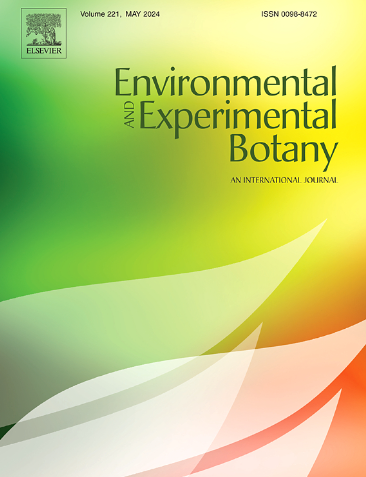Unraveling the effects of Caulerpa metabolites on Posidonia oceanica apical and vertical shoots at physiological and molecular level
IF 4.7
2区 生物学
Q2 ENVIRONMENTAL SCIENCES
引用次数: 0
Abstract
Invasive Caulerpa species produce bioactive metabolites that can disrupt seagrass physiology, yet their specific effects on different shoot types remain poorly understood. This study examines the physiological and molecular responses of Posidonia oceanica apical and vertical shoots to two major Caulerpa-derived metabolites: caulerpenyne (CYN) from C. taxifolia and caulerpin (CAU) from C. cylindracea. Exposure to 25 μM CYN led to a 90 % mortality in adult leaves of apical shoots and significantly inhibited juvenile leaf formation in vertical shoots, despite no effect on chlorophyll content. Conversely, 25 μM CAU stimulated juvenile leaf emergence but reduced adult leaf elongation by 93% and impaired chlorophyll content in both shoot types. Proteomic analysis revealed significant protein downregulation in CYN-exposed apical shoots, particularly those involved in photosynthesis, stress response, brassinosteroid signaling, and fatty acid metabolism. CYN also upregulated lactate dehydrogenase and glyoxalase while disrupting Ca²⁺/calmodulin signaling. CAU exposure led to a decrease in histone H4 but increased the abundance of protective proteins, including catalase, phenylalanine ammonia-lyase, and Hsp70, mitigating oxidative damage. In vertical shoots, CYN enhanced fatty acid biosynthesis, lipoxygenase activity, phosphorylation pathways, and sulfur metabolism, while CAU suppressed methylation and increased histone H3. Apical shoots exhibited greater susceptibility to the phytotoxic effects of CYN than vertical shoots, while both showed great resilience to CAU. Given the critical role of apical shoots in clonal propagation, their heightened vulnerability to CYN may contribute to the decline of P. oceanica meadows in C. taxifolia-invaded regions. These findings reveal the molecular and physiological mechanisms of seagrass responses to invasive macroalgal toxins.
在生理和分子水平上揭示茎叶孢代谢物对海洋波西多尼根尖和竖直芽的影响
入侵的Caulerpa物种产生的生物活性代谢物可以破坏海草的生理,但它们对不同芽类型的具体影响尚不清楚。本研究研究了大洋Posidonia oceanica的顶端和垂直梢对两种主要的茎叶衍生代谢物——杉木茎叶碱(CYN)和白茅茎叶素(CAU)的生理和分子反应。暴露于25 μM CYN下,顶芽成叶死亡率达90% %,垂直芽幼叶形成受到显著抑制,但叶绿素含量未受影响。相反,25 μM CAU刺激幼叶出芽,但使成年叶伸长减少93%,并损害了两种芽型的叶绿素含量。蛋白质组学分析显示,cyn暴露的顶芽中蛋白质显著下调,特别是与光合作用、胁迫反应、油菜素内酯信号传导和脂肪酸代谢有关的蛋白质。CYN还上调乳酸脱氢酶和乙二醛酶,同时破坏ca2 + /钙调素信号传导。CAU暴露导致组蛋白H4减少,但增加了保护蛋白的丰度,包括过氧化氢酶、苯丙氨酸解氨酶和Hsp70,减轻了氧化损伤。在竖直茎中,CYN增强脂肪酸生物合成、脂氧合酶活性、磷酸化途径和硫代谢,而CAU抑制甲基化并增加组蛋白H3。顶芽对CYN的敏感性高于竖直芽,但对CAU的抗逆性均较强。考虑到顶芽在无性系繁殖中的关键作用,顶芽对CYN的脆弱性增加可能是杉木入侵区海洋草甸衰落的原因之一。这些发现揭示了海草对入侵大藻毒素反应的分子和生理机制。
本文章由计算机程序翻译,如有差异,请以英文原文为准。
求助全文
约1分钟内获得全文
求助全文
来源期刊

Environmental and Experimental Botany
环境科学-环境科学
CiteScore
9.30
自引率
5.30%
发文量
342
审稿时长
26 days
期刊介绍:
Environmental and Experimental Botany (EEB) publishes research papers on the physical, chemical, biological, molecular mechanisms and processes involved in the responses of plants to their environment.
In addition to research papers, the journal includes review articles. Submission is in agreement with the Editors-in-Chief.
The Journal also publishes special issues which are built by invited guest editors and are related to the main themes of EEB.
The areas covered by the Journal include:
(1) Responses of plants to heavy metals and pollutants
(2) Plant/water interactions (salinity, drought, flooding)
(3) Responses of plants to radiations ranging from UV-B to infrared
(4) Plant/atmosphere relations (ozone, CO2 , temperature)
(5) Global change impacts on plant ecophysiology
(6) Biotic interactions involving environmental factors.
 求助内容:
求助内容: 应助结果提醒方式:
应助结果提醒方式:


